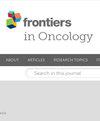评估尿 C 反应蛋白作为胰腺导管腺癌早期检测生物标记物的作用
IF 3.5
3区 医学
Q2 ONCOLOGY
引用次数: 0
摘要
胰腺导管腺癌(PDAC)是导致全球癌症相关死亡的主要原因之一。迄今为止,还没有特定的筛查或诊断测试可用于早期检测 PDAC。因此,大多数患者被诊断为晚期或转移性疾病,导致预后不良。在这项研究中,我们旨在评估尿液 CRP(uCRP)单独或与我们之前建立的尿液生物标记物面板(REG1B、LYVE1 和 TFF1)联合用于早期检测 PDAC 的诊断价值。共分析了来自多个中心的 534 份尿液样本:其中 93 份来自健康人,265 份来自良性肝胆疾病患者,176 份来自 PDAC 患者。uCRP和尿液生物标记物面板使用商业ELISA测定法进行评估,而血浆CA19-9和血液CRP(bCRP)则使用罗氏Cobas平台进行测量。统计分析采用多元逻辑回归和非参数 Kruskal-Wallis 检验。采用了内部验证方法,并报告了经过验证的 AUC 估计值,以确保准确性。在健康和良性对照组与 PDAC 样本组之间,uCRP 的中位数存在明显差异(p &pamp;lt;0.001)。当uCRP与尿液生物标记物组合时,在健康与PDAC样本组、良性与PDAC样本组以及健康与良性与PDAC样本组中的AUC分别为0.878(95% CI:0.802-0.931)、0.798(95% CI:0.738-0.859)和0.813(95% CI:0.758-0.869)。然而,将血浆 CA19-9 加入尿液生物标记物面板后,结果更好,在健康 vs PDAC、良性 vs PDAC 和健康与良性 vs PDAC 比较中,AUC 分别为 0.978(95% CI:0.959-0.996)、0.911(95% CI:0.873-0.949)和 0.919(95% CI:0.883-0.955)。总之,我们的研究表明,测量尿液中的 CRP 是一种可行的分析方法,uCRP 有可能成为包括其他癌症类型在内的各种疾病的一种有前途的生物标记物。本文章由计算机程序翻译,如有差异,请以英文原文为准。
Evaluation of urinary C-reactive protein as an early detection biomarker for pancreatic ductal adenocarcinoma
Pancreatic ductal adenocarcinoma (PDAC) is one of the leading causes of cancer-related death worldwide. Up to now, no specific screening or diagnostic tests are available for early PDAC detection. As a result, most patients are diagnosed with advanced or metastatic disease, which leads to a poor prognosis. In this study, we aimed to evaluate the diagnostic value of urinary CRP (uCRP) alone and in combination with our previously established urine biomarker panel (REG1B, LYVE1 and TFF1) for early detection of PDAC. A total of 534 urine samples from multiple centres were analysed: 93 from healthy individuals, 265 from patients with benign hepatobiliary diseases and 176 from PDAC patients. The uCRP and the urinary biomarker panel were assessed using commercial ELISA assays, while plasma CA19-9 and blood CRP (bCRP) were measured using Roche Cobas platform. Multiple logistic regression and nonparametric Kruskal–Wallis test were used for statistical analysis. An internal validation approach was applied, and the validated AUC estimators were reported to ensure accuracy. A significant difference was observed in the medians of uCRP between healthy and benign controls and PDAC sample groups (p < 0.001). uCRP levels were not dependent on gender and age, as well as cancer stage. When uCRP was combined with the urinary biomarker panel, it achieved AUCs of 0.878 (95% CI: 0.802-0.931), 0.798 (95% CI: 0.738-0.859) and 0.813 (95% CI: 0.758-0.869) in healthy vs PDAC, benign vs PDAC and healthy and benign vs PDAC sample groups, respectively. However, adding plasma CA19-9 to the urinary biomarker panel yielded a better performance, with AUCs of 0.978 (95% CI: 0.959-0.996), 0.911 (95% CI: 0.873-0.949) and 0.919 (95% CI: 0.883-0.955) in the healthy vs PDAC, benign vs PDAC and healthy and benign vs PDAC comparisons, respectively. In conclusion, we show that measuring CRP in urine is a feasible analytical method, and that uCRP could potentially be a promising biomarker in various diseases including other cancer types.
求助全文
通过发布文献求助,成功后即可免费获取论文全文。
去求助
来源期刊

Frontiers in Oncology
Biochemistry, Genetics and Molecular Biology-Cancer Research
CiteScore
6.20
自引率
10.60%
发文量
6641
审稿时长
14 weeks
期刊介绍:
Cancer Imaging and Diagnosis is dedicated to the publication of results from clinical and research studies applied to cancer diagnosis and treatment. The section aims to publish studies from the entire field of cancer imaging: results from routine use of clinical imaging in both radiology and nuclear medicine, results from clinical trials, experimental molecular imaging in humans and small animals, research on new contrast agents in CT, MRI, ultrasound, publication of new technical applications and processing algorithms to improve the standardization of quantitative imaging and image guided interventions for the diagnosis and treatment of cancer.
 求助内容:
求助内容: 应助结果提醒方式:
应助结果提醒方式:


